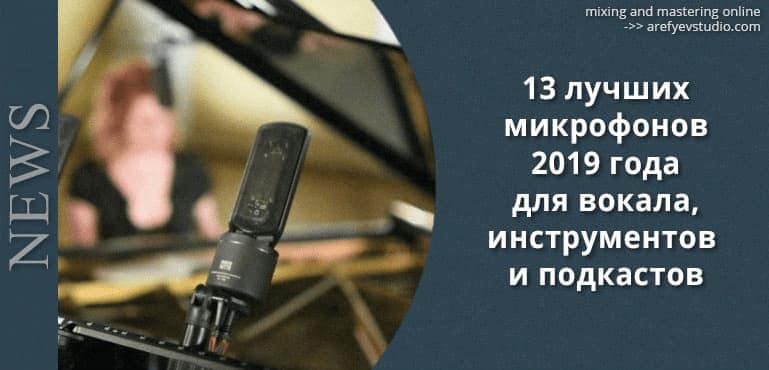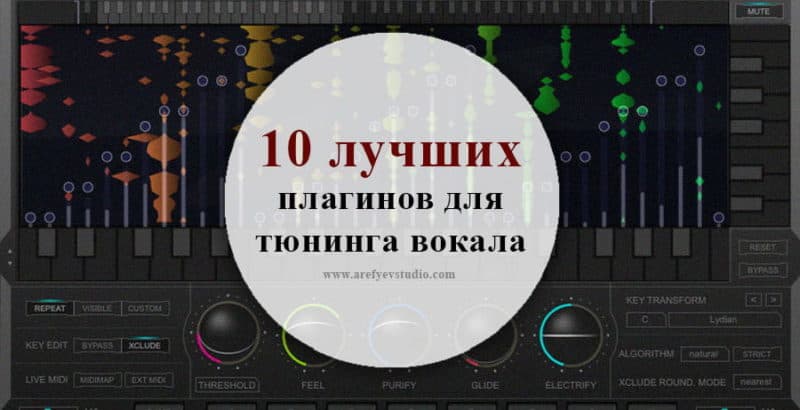Capturing a musical source is the essence of what a microphone provides to producers, artists and engineers around the world. A modest transducer generates sound waves into electrical signals that can be manipulated in a digital audio station. However, not all microphones are created equal, and choosing the right one for the customer can be quite difficult.
Which microphone is perfect for vocals, guitars, or podcast recordings? Does an expensive microphone mean better?
Given all this, we have put together the best microphones for every need and situation. Whether you are choosing a budget model or looking for something for a professional studio, there is a suitable microphone here.
1. AKG C636

Great handheld capacitor. Price: $ 499. Type: capacitor, cardioid. Application: vocals. Connection: XLR. Clear, well-balanced response, excellent off-axis attenuation.
Like a condenser microphone, the C636 is inherently more complex than its dynamic siblings. Feedback suppression and processing noise issues must be balanced with trade-offs in sound quality. For a simple black appearance and lightness in the hand, the C636 boasts serious design solutions, but does it deserve it? Yes. The sound is clear, dense, more linear and “real” than its dynamic analog microphones.
More details: AKG C636.
2. Lewitt LCT 640 TS

The best innovation. Price $ 899. Type: capacitor, Omni, wide cardioid, cardioid, supercardioid. Application: vocals. Connection: XLR, mini XLR.
Despite being visually similar to the Lewitt Audio LCT 640, their new LCT 640 TS is equipped with a double diaphragm capsule and includes an integrated Lewitt capsule matching system. TS stands for Twin System: it works either in normal mode with multiple microphones or in dual mode, providing independent access to both aperture outputs. This allows you to adjust the capture template after recording, and also opens up some stereo recording options. In dual mode, access to the second output of the membrane is through a miniature three-pin connector on the side of the case, and the carrying case has a mini three-pin XLR connecting cable, as well as accessories such as foam glass, a suspended cradle (spider), a microphone cover and a pretty elegant magnetic pop filter. In general, this is a well-built and stylish equipment.
More details: Lewitt LCT 640 TS.
3. Aston Microphones Origin
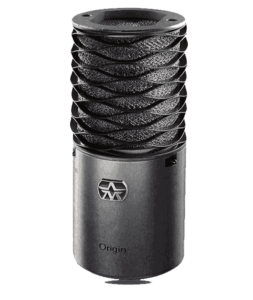
Great inexpensive capacitor. Price: $ 269. Type: capacitor, cardioid. Application: vocals. Connection: XLR.
Aston Origin may be at a competitive price, but has originality, which is not uncommon in this range. Origin is a fixed-pattern (cardioid) capacitor and the smaller of two Aston microphones: the larger Spirit is a multi-circuit capacitor with additional 10dB available pads. There are two switches on the stainless steel case: 10 dB gasket and 80 Hz low-pass filter. The XLR connector is located on the underside of the microphone, as is the jack for attaching the stand. This last feature means that a microphone clip is not required, although this limits the angle selection to the stand. The wave-shaped external spring / net acts as a shock absorber for the capsule, and behind it is a stainless steel protective net.
More details: Aston Microphones Origin.
4. Sontronics Aria

The best valve microphone. Price: $ 1199. Type: capacitor, cardioid. Application: vocals, instruments. Connection: XLR. Power Supply: 12AX7 / ECC83 tube.
When everything is connected, the first thing that is obvious to Aria is how natural it sounds. It gives a slight rise in the upper middle region (giving more “presence”). In addition, there is no high-frequency deception or fragility. Draws attention to low and mid frequencies. They seem warm and solid. Cardioid polarity is quite wide in both horizontal and vertical directions. The vocals produce a natural sound. When recording an acoustic guitar, juicy frequencies are captured, excluding the echo of the lower middle. Also suitable for other string and percussion sources.
More details: Sontronics Aria.
5. Rode NT1

The best mic available. Price: $ 395. Type: capacitor, cardioid. Application: vocals, instruments. Connection: XLR.
Low noise and high sound quality. The original NT1 Rode was released about 20 years ago, and a few years later NT1A appeared. Now the company has returned to its old name with the release of the new NT1 model, which is very similar to NT1A, but in fact has been completely redesigned from scratch. The only common feature is the mesh grill. So what does this redesign include? The first is the new HF6 capsule. It exhibits an extremely low noise level. Rode also claims that the NT1 is the world’s quietest 1-inch cardioid capacitor, thanks to high-quality electronics that support noise levels up to 4.5 dBA.
More details: Rode NT1.
— See also: 10 best drum libraries for NI Kontakt 5 for 2017 —
6. Slate Digital VMS

The best virtual modeling microphone system. Price: $ 999. Type: capacitor, cardioid. Application: vocals, instruments. Connection: XLR.
Earlier, we wrote about systems simulating vintage microphone models, so we could not help but include such a good product in this article. Classic condenser microphones with large capsules are without a doubt one of the most sought after and expensive items on the list. With the original Neumann U47, costing up to $ 10,000, most of these microphones are unavailable to the average studio owner and, of course, only to the tiny minority of home studios. Slate Digital took as the basis the impossibility of buying several expensive models, therefore, it offered the market one model with additional software that solves many problems.
More details: Slate Digital VMS.
7. Audio Technica AT5040
The best high quality condenser microphone. Price: $ 2999. Type: capacitor, cardioid. Application: vocals, instruments. Connection: XLR.
This is a large condenser microphone with the same large aperture, which is difficult to find flaws. The focus is on frequency response, build quality and sound. The new AT5040 from Audio Technica combines all the features of a typical high-performance phantom-powered condenser microphone with its discrete component design, low noise, high sound pressure level and decent mount. It is worth mentioning the improved mechanism for decoupling the internal capsules and the fact that it is 100% assembled and checked manually.
8. sE Electronics sE2200a II

The best mid-range multi-color microphone. Starting price: $ 399. Type: capacitor, cardioid, omni. Application: vocals, instruments. Connection: XLR.
Like many condenser microphones with large capsules, omni mode on the sE2200a II is hardly a strong point of this microphone, and the MkII response shows a noticeable drop (6 dB) near the 5 kHz mark. However, this was not so obvious during use, and, perhaps, was slightly offset by a smooth increase in frequency above 7 kHz. In any case, both templates are useful inclusions and will save you from having to buy or set up another microphone if you want to try different templates. Overall, the sE update was successful, and when combined with the multi-pattern option, the 2200a MkII is more desirable than ever. The ability to use multiple patterns has slightly increased the cost of the product, but there is always a fixed cardioid version if you are limited on a budget.
More details: sE Electronics sE2200a II.
9. Lewitt LCT 540 S
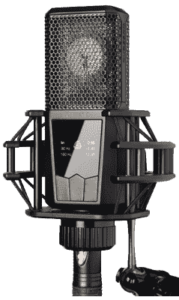
The quietest for recording vocals. Price: $ 699. Type: capacitor, cardioid. Application: vocals, instruments. Connection: XLR.
The LCT540 S is a completely modern microphone in style and function, but what about sound? This cardioid capacitor demonstrates its quality immediately when connected. It is comparable to more expensive models. The HF-lifting condenser microphone is thin and has no phase peaks, it retains its natural character and easy control. The dynamic range and the volume margin are quite large without a pad being used, and the output level reduces the noise level of the preamplifier.
More details: Lewitt LCT 540 S.
10. Audio-Technica AE2300
The best compact alternative to SM57. Price: $ 269. Type: dynamic, cardioid. Application: tools. Connection: XLR.
The AE2300 is a cardioid design that is widely used with high noise levels, making it ideal for percussion, guitar amps and brass. It is also quite compact (less than 10 cm long), which is convenient in real conditions. The brass body and top grille look durable, and the rubberized clip provides some mechanical insulation. In general, this is a properly made microphone. The patented double-dome diaphragm improves high-frequency and transient response.
— See also: 5 best online music creation sites —
11. Sontronics Solo

The best alternative to SM58. Price: $ 135. Type: dynamic, cardioid. Application: vocals, instruments. Connection: XLR.
Solo is a well-weighted, rugged microphone. The grill has a flat front, which not only gives a more stable distance when approaching, but is also less likely to interfere with your teeth in a noisy club concert. The output impedance is higher than that of an average dynamic microphone, and this is reflected at a workable level in the preamplifier. This bodes well for noise control during live performances and in the studio.
More details: Sontronics Solo.
12. Rode NTR

The best ribbon microphone. Price: $ 999. Type: tape. Application: vocals, instruments. Connection: XLR.
NTR is active, powered by 48 V phantom power and has a built-in transformer that provides high output power, so the model is not as demanding on preamps as other tape microphones. On a variety of sound sources, it gives a natural transmission, with a lot of low frequencies, and transparent aerial highs.
More details: Rode NTR.
13. M-Audio Uber Mic
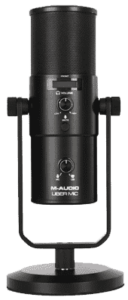
Best for comprehensive recording and podcasting. Price: $ 99. Type: capacitor, cardioid, omni, stereo. Application: vocals, instruments, podcasts. Connection: USB.
M-Audio’s Uber Mic is one of the cheapest and well-designed USB microphones, which includes stereo mode and three common monopolar patterns (omni, cardioid, figure-8). The built-in controls for microphone gain, mute, headphone level, zero-delay mixing and polar pattern selection, along with a convenient miniature LCD display, make the job enjoyable, and the U-shaped microphone mount is equally well screwed into the attached desktop, or can be attached to the counter. Audio only works up to 16bit / 48000hz. However, for such little money, the model provides a good value for money.
More details: M-Audio Uber Mic.

